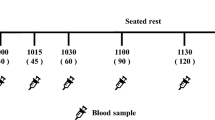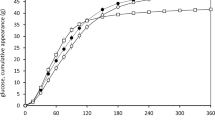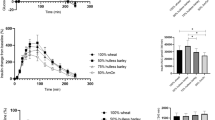Abstract
Objective: To determine the effect of adding chickpea flour or extruded chickpea flour to white bread on palatability and postprandial glycaemia, insulinaemia and satiety.
Design: A randomised, single-blind, cross-over study of four 50 g available carbohydrate breakfasts.
Setting: School of Exercise and Nutrition Sciences, Deakin University.
Subjects: In all, 12 healthy subjects were recruited through posted notices. Totally, 11 (nine male, two female) completed the study (mean±s.e.m.; age 32±2 y; body mass index, 24.7±0.8 kg/m2).
Intervention: After overnight fasting, subjects consumed a control (white) bread (WB) breakfast twice, a chickpea bread (CHB) breakfast once and an extruded chickpea bread (EXB) breakfast once. Palatability and postprandial blood glucose, insulin and satiety responses were determined. Following this, food intakes from an ad libitum buffet and for the remainder of the day were assessed.
Results: A trend towards a lower incremental area under the curve (IAUC) of glucose for the CHB breakfast compared to the WB breakfast was observed (P=0.087). The IAUC of insulin and insulinaemic index (II) of the CHB breakfast were higher (P<0.05) than for the WB breakfast. No differences in glycaemic index (GI), satiety response, food intake or palatability were observed.
Conclusions: CHB and EXB demonstrated acceptable palatability. CHB demonstrated some hypoglycaemic effect compared to WB, but neither CHB nor EXB demonstrated effects on satiety or food intake. The hyperinsulinaemic effect of CHB observed in this study requires further investigation.
Sponsorship: Grains Research and Development Corporation.
This is a preview of subscription content, access via your institution
Access options
Subscribe to this journal
Receive 12 print issues and online access
$259.00 per year
only $21.58 per issue
Buy this article
- Purchase on Springer Link
- Instant access to full article PDF
Prices may be subject to local taxes which are calculated during checkout



Similar content being viewed by others
References
Alonso R, Grant G, Dewey P & Marzo F (2000): Nutritional assessment in vitro and in vivo of raw and extruded peas (Pisum sativum L.). J. Agric. Food Chem. 48, 2286–2290.
Anderson JW, Smith BM & Washnock CS (1999): Cardiovascular and renal benefits of dry bean and soybean intake. Am. J. Clin. Nutr. 70, 464S–474S.
AOAC (1990): Official Methods of Analysis. Washington, DC: Association of Official Analytical Chemist.
Bjorck I, Lilijberg H & Ostman E (2000): Low glycaemic-index foods. Br. J. Nutr. 83, S149–S155.
Bourdon I, Olson B, Backus R, Richter BD, Davis PA & Schneeman BO (2001): Beans, as a source of dietary fiber, increase cholecystokinin and apolipoprotein B48 response to test meals in men. J. Nutr. 131, 1485–1490.
Brand-Miller J, Holt SH, de Jong V & Petocz P (2003): Cocoa powder increases postprandial insulinemia in lean young adults. J. Nutr. 133, 3149–3152.
Brand-Miller JC, Holt SHA, Pawlak DB & McMillan J (2002): Glycemic index and obesity. Am. J. Clin. Nutr. 76, S281–S285.
Calbet JA & MacLean DA (2002): Plasma glucagon and insulin responses depend on the rate of appearance of amino acids after ingestion of different protein solutions in humans. J. Nutr. 132, 2174–2182.
Chavan JK, Kadam SS & Salunkhe DK (1986): Biochemistry and technology of chickpea (Cicer arietinum L.) seeds. Crit. Rev. Food Sci. Nutr. 25, 107–158.
Clark RL & Johnson SK (2002): Sensory acceptability of foods with added lupin (Lupinus angustifolius) kernel fiber using pre-set criteria. J. Food Sci. 67, 356–362.
Englyst HN & Hudson GJ (1996): The classification and measurement of dietary carbohydrates. Food Chem. 57, 15–21.
Englyst KN, Vinoy S, Englyst HN & Lang V (2003): Glycaemic index of cereal products explained by their content of rapidly and slowly available glucose. Br. J. Nutr. 89, 329–339.
Foster-Powell K, Holt SHA & Brand-Miller JC (2002): International table of glycemic index and glycemic load values: 2002. Am. J. Clin. Nutr. 76, 5–56.
Goni I & Valentin-Gamazo C (2003): Chickpea flour ingredient slows glycemic response to pasta in healthy volunteers. Food Chem. 81, 511–515.
Guy R (2001): Extrusion Cooking Technologies and Applications. Cambridge: Woodhead Publishing Limited.
Holt S, Brand J, Soveny C & Hansky J (1992): Relationship of satiety to post prandial glycaemic, insulin and cholecystokinin responses. Appetite 18, 129–141.
Holt SHA, Brand Miller JC, Petocz P & Farmakalidis E (1995): A satiety index of common foods. Eur. J. Clin. Nutr. 49, 675–690.
Jenkins DJA, Kendall CWC, Augustin LSA, Franceschi SMH, Marchie A, Jenkins AL & Axelsen M (2002): Glycemic index: overview of implications in health and disease. Am. J. Clin. Nutr. 76, S266–S273.
Khan MA, Akhtar N, Ullah I & Jaffery S (1995): Nutritional evaluation of desi and kabuli chickpeas and their products commonly consumed in Pakistan. Int. J. Food Sci. Nutr. 46, 215–223.
Leeds AR (2002): Glycemic index and heart disease. Am. J. Clin. Nutr. 76, S286–S289.
Leterme P (2002): Recommendations by health organisations for pulse consumption. Br. J. Nutr. 88, S239–S242.
Ludwig DS (1999): High glycaemic index foods, overeating and obesity. Pediatrics [online] 103, e26.
Meance S, Achour L & Briend A (1999): Comparison of starch digestibility of a blended food prepared with and without extrusion cooking. Eur. J. Clin. Nutr. 53, 844–848.
Messina MJ (1999): Legumes and soybeans: overview of their nutritional profiles and health effects. Am. J. Clin. Nutr. 70, 439S–450S.
Milan-Carrillo J, Reyes-Moreno C, Camacho-Hernandez IL & Rouzaud- Sandez O (2002): Optimisation of extrusion process to transform hardened chickpea (Cicer arietinum L.) into a useful product. J. Sci. Food Agric. 82, 1718–1728.
Paul AA & Southgate DAT (1978): McCance and Widdowson's the Composition of Foods. London: HMSO.
Rizkalla S, Bellisle F & Slama G (2002): Health benefits of low glycaemic index foods, such as pulses, in diabetic patients and healthy individuals. Br. J. Nutr. 88, S255–S262.
Roberts SB (2000): High-glycemic index foods, hunger, and obesity: is there a connection? Nutr. Rev. 58, 163.
Schneider AVC (2002): Overview of the market and consumption of pulses in Europe. Br. J. Nutr. 88, S243–S250.
Thorne M, Thompson LU & Jenkins DJA (1983): Factors affecting starch digestibility and the glycaemic response with special reference to legumes. Am. J. Clin. Nutr. 38, 481–488.
van Haeften TW, Voetberg GA, Gerich JE & van der Veen EA (1989): Dose-response characteristics for arginine-stimulated insulin secretion in man and influence of hyperglycemia. J. Clin. Endocrinol. Metab. 69, 1059–1064.
Willett W, Manson J & Liu S (2002): Glycemic index, glycemic load and risk of type 2 diabetes. Am. J. Clin. Nutr. 76, S274–S280.
Wolever TMS (1990): The glycemic index. World Rev. Nutr. Diet. 62, 120–185.
Wolever TMS & Jenkins DJA (1986): The use of the glycemic index in predicting the blood glucose response to mixed meals. Am. J. Clin. Nutr. 43, 167–172.
Wolever TMS, Jenkins DJA, Ocana AM, Rao VA & Collier GR (1988): Second-meal effect: low-glycemic-index foods eaten at dinner improve subsequent breakfast glycemic response. Am. J. Clin. Nutr. 48, 1041–1047.
Acknowledgements
We thank Carl Gibbons for database construction, Damien Jolley for assistance with statistical design and analysis, Andrew Garnham for performing catheterization, Rachel Kelly and Aung Htoon for preparation of extruded chickpea flour and Amynta Baxter and Amanda Hawkins for technical assistance. We would also like to thank study participants for their time.
Author information
Authors and Affiliations
Corresponding author
Additional information
Guarantor: SK Johnson.
Contributors: SKJ was involved in all parts of the study from conception to preparation of the final manuscript. SJT and RSH performed the experimental aspects of the human study and some data analysis.
Rights and permissions
About this article
Cite this article
Johnson, S., Thomas, S. & Hall, R. Palatability and glucose, insulin and satiety responses of chickpea flour and extruded chickpea flour bread eaten as part of a breakfast. Eur J Clin Nutr 59, 169–176 (2005). https://doi.org/10.1038/sj.ejcn.1602054
Received:
Revised:
Accepted:
Published:
Issue Date:
DOI: https://doi.org/10.1038/sj.ejcn.1602054
Keywords
This article is cited by
-
Bioactive Properties of Bread Formulated with Plant-based Functional Ingredients Before Consumption and Possible Links with Health Outcomes After Consumption- A Review
Plant Foods for Human Nutrition (2022)
-
Pulse consumption improves indices of glycemic control in adults with and without type 2 diabetes: a systematic review and meta-analysis of acute and long-term randomized controlled trials
European Journal of Nutrition (2022)
-
Chickpeas suppress postprandial blood glucose concentration, and appetite and reduce energy intake at the next meal
Journal of Food Science and Technology (2017)
-
Efficacy of different fibres and flour mixes in South-Asian flatbreads for reducing post-prandial glucose responses in healthy adults
European Journal of Nutrition (2017)
-
Organoleptic and glycemic properties of chickpea-wheat composite breads
Journal of Food Science and Technology (2015)



